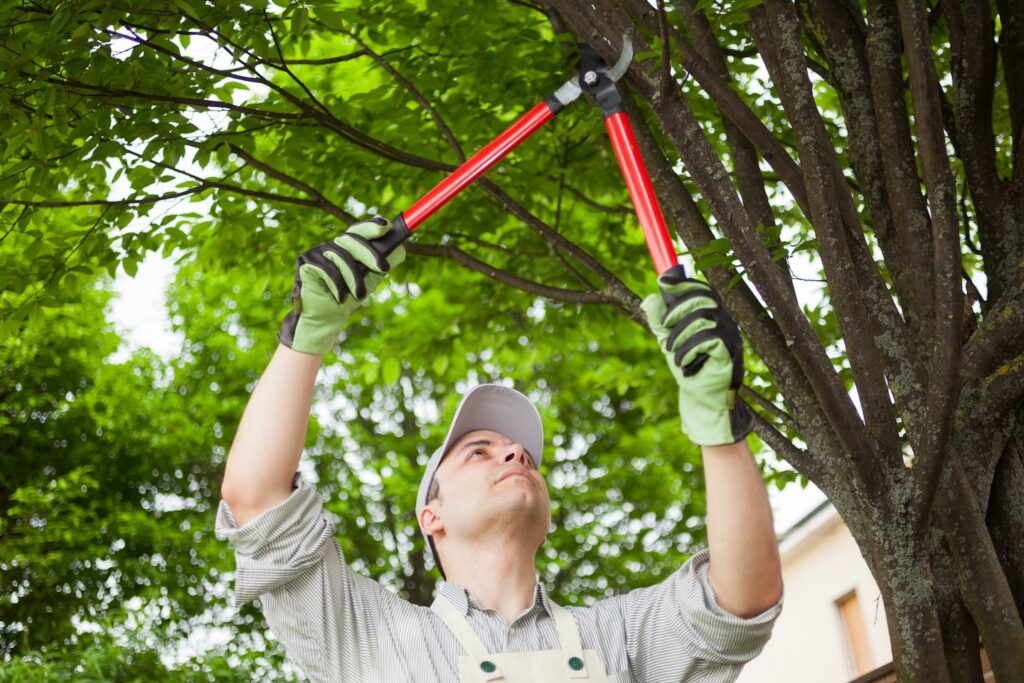Overgrown trees making your yard look worse for the wear? It might be time to give those branches a trim! Before you grab your pruning shears or call a professional, it’s essential to understand the costs associated with tree trimming. Keep reading for a breakdown of tree trimming costs, what factors affect pricing, and everything you need to know about tree trimming expenses for Fall 2024.
Table of Contents
- Average Tree Trimming Costs
- Cost by Location
- Factors that Affect Tree Trimming Cost
- Types of Trees
- Height of Trees
- Time of Year
- Tree Health
- Accessibility
- Number of Trees
- Tree Trimming vs. Tree Pruning
- Additional Considerations & Factors
- FAQs
- Conclusion
Average Tree Trimming Costs

Before we dive into the details, let’s address the burning question: How much does tree trimming typically cost?
- National Average Cost: $475
- Typical Price Range: $315 – $700
- Low-End Cost: $85 (for small trees or minimal work)
- High-End Cost: $1,267 (for large trees or extensive work)
These numbers represent the average cost of tree trimming, but the tree trimming prices can vary depending on the project’s size and complexity. Additionally, the tree trimming cost per hour can differ based on your region and the service provider.
Cost by Location
Tree trimming prices can vary significantly depending on where you live. Here’s a quick look at the average price for tree trimming in some major U.S. cities with plenty of trees:
| City | Average Cost Range |
| Seattle, WA | $400 – $800 |
| Portland, OR | $350 – $750 |
| Atlanta, GA | $300 – $650 |
| Austin, TX | $375 – $725 |
| Boston, MA | $450 – $850 |
| Denver, CO | $325 – $700 |
Remember, these are just averages. Your actual tree trimming service cost may differ based on specific factors of your tree trimming project.
Factors that Affect Tree Trimming Cost
Several key factors influence the cost to trim large trees and overall tree cutter service cost. Understanding these can help you better estimate your potential expenses.
1. Types of Trees

Different tree species require different levels of care and expertise, which affects the tree trimming cost:
- Crepe Myrtle: $85 – $475
- Oak: $450 – $1,400
- Pine: $300 – $1,700
- Palm: $450 – $1,100 (palm tree trimming cost tends to be on the lower end for most projects)
- Cypress: $475 – $1,150
2. Height of Trees

The height of your tree is one of the most significant factors in determining the cost to trim large trees:
- Small trees (up to 30 feet): $85 – $400
- Medium trees (30-60 feet): $150 – $775
- Large trees (60+ feet): $325 – $1,700
As expected, the taller the tree, the higher the tree trimming cost.
3. Time of Year

Timing can impact your tree trimming cost:
- Late winter (February-March): Often the most affordable time
- Spring and summer: Typically busier and more expensive
If you’re looking for the best deal, consider scheduling your tree trimming in the late winter when the tree trimming cost per hour might be lower due to lower demand.
4. Tree Health

The health of your tree can affect trimming costs:
- Healthy trees: Standard pricing
- Diseased or pest-infested trees: May require additional care, increasing tree trimming service cost by 25-50%
5. Accessibility

The location of your tree matters:
- Easy access: Standard pricing
- Near structures or power lines: Can increase tree trimming prices by 20-50%
- Difficult terrain: May add 25-75% to the tree branch removal cost
6. Number of Trees

Multiple trees will naturally increase your overall cost:
- Single tree: Average cost of tree trimming is around $475
- Multiple trees: Offers some economies of scale, but expect to pay more overall
Tree Trimming vs. Tree Pruning
While often used interchangeable, tree trimming and pruning are different services:
- Tree Trimming: Focuses on shaping the tree for aesthetic purposes and removing overgrown branches. It typically costs between $315 – $700 depending on the tree’s size, accessibility, and location.
- Tree Pruning: Aims to improve tree health and structure by removing dead, diseased, or dangerous branches. The tree pruning cost generally ranges between $175 – $1,800, based on the complexity of the job.
Additional Considerations & Factors

When budgeting for tree trimming service costs, keep these additional factors in mind:
- Risks: Trimming large or diseased trees can be dangerous. Always prioritize safety over cost.
- Licensing & Insurance: Make sure your tree trimming service is licensed and insured to protect yourself from liability.
- Wildlife: If animals are nesting in the tree, special care (and potentially additional costs) may be required.
- Debris Removal: Ask if cleanup and debris removal are included in the quote. If not, it could add $100 – $600 to your total tree branch removal cost.
- Equipment: Special equipment like cherry pickers for tall trees can increase the tree trimming cost per hour.
FAQs
How do you tell if a tree needs to be trimmed?
To determine if a tree needs to be trimmed, look for dead or broken branches, branches that cross or rub against each other, or branches growing too close to structures or power lines. If your tree looks unshapely or overgrown, it might be time for a trim.
Do trees grow back after trimming?
Yes, trees will continue to grow after trimming. Regular trimming can actually promote healthier growth and a more attractive shape.
Is tree pruning sealer necessary?
Generally, no. Most arborists now recommend against using tree pruning sealers as they can interfere with the tree’s natural healing process.
Can you over-trim a tree?
Yes you can. Over-trimming can stress a tree and make it more susceptible to disease and pests. It’s best to follow the “one-third rule”—never remove more than one-third of a tree’s canopy at one time.
How often do you need to trim trees?
The frequency of tree trimming depends on the tree species and its growth rate, but most trees benefit from trimming every 3-5 years. Young trees may need more frequent trimming to establish a good structure.
Does trimming trees keep them healthy?
Yes, proper trimming can improve a tree’s health by removing dead or diseased branches, improving air circulation, and promoting better structure.
Conclusion
Proper tree trimming is essential for maintaining your trees’ health and appearance, but understanding the costs involved can help you plan accordingly. The cost to trim trees varies depending on factors like the tree’s size, location, and condition. Regular trimming helps avoid more expensive tree removal or emergency services down the road by keeping trees healthy and minimizing potential hazards.
If you need help with this difficult and potentially hazardous task, book a helping hand! Taskers are skilled at keeping your outdoor space in top shape while making sure your trees get the professional care they need.














